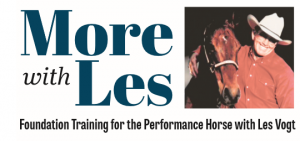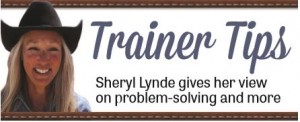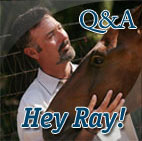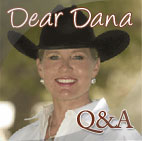Steps to great stops
Foundation Training for the Performance Horse with Les Vogt
 Just like with everything else, there is a program for developing great stops on your horse, and the exercise we call the collected stop is the first phase. This stop exercise is critically important because it is where you begin to teach your horse to stop with the correct form.
Just like with everything else, there is a program for developing great stops on your horse, and the exercise we call the collected stop is the first phase. This stop exercise is critically important because it is where you begin to teach your horse to stop with the correct form.
I think it works so well because when you do it, you’ll be pushing your horse into the stop mode rather than pulling on him. We push the horse by clucking, riding him up with our legs and softening his neck. When he assumes perfect posture, then we can let him stop. He develops great form, and the stop becomes the big reward instead of a punishment or something he starts to dread.
Looking for the perfect horse
 When looking to purchase a horse, an important point to remember is that someone in the relationship needs to have more experience than the other.
When looking to purchase a horse, an important point to remember is that someone in the relationship needs to have more experience than the other.
If the rider is green, or a beginner, the horse selected needs to have more experience than the rider. If the horse is green, or young, the rider needs to have more experience than the horse. There is an old equation that has proven itself timeless and is spot-on: Green + Green = Black and Blue.
In addition to taking an accurate inventory of the rider’s skills and ability, another essential component to a successful pairing is to establish the desired use of the horse. Whatever discipline the rider will be pursuing, whether it be a specific competitive sport or trail riding, the chosen horse needs to have had that experience in his riding career.
Collected Stops
Foundation Training for the Performance Horse with Les Vogt
![]()
 he most important ingredient to a stop is collection, and collection is achieved through weight reversal from the forehand to hindquarters. How does it happen? Something I haven’t talked about yet is that to me, horses have two motors. They have a front motor and a back motor. In other words, their front legs are motivated by one motor system and the back legs by another. That’s why a horse can be loping in front and trotting in back.
he most important ingredient to a stop is collection, and collection is achieved through weight reversal from the forehand to hindquarters. How does it happen? Something I haven’t talked about yet is that to me, horses have two motors. They have a front motor and a back motor. In other words, their front legs are motivated by one motor system and the back legs by another. That’s why a horse can be loping in front and trotting in back.
Consequently, the front legs can be slowed down, so they are carrying less of the weight, and the back legs sped up—they don’t have to be equal. So to collect a horse, we need to slow the front legs down and rev up the back legs. We might liken that to a cartoon character like Bugs Bunny, whose back legs are trying to pass the front, and the top line is round. We really only get that exaggerated in a sliding stop, but since that’s what we’re looking to achieve, developing the correct form is critical.
I went for years, easily 10 years, where I went to stop a horse by just pulling him. We hammered them. We ran ’em and ran ’em and stopped ’em and stopped ’em and then ran ’em again! And we had no idea that there was a proper form. Nobody talked about it; the bar just wasn’t that high yet, and we didn’t have that much structure in our western performance riding at that point. Now that we do, we can take many horses that would not have made it in that day and time and make them good stoppers, and we have a lot more fun—as do the horses, I’m sure!
So, what is the proper form for the stop? The horse needs to approach the stop with collection and power so that his top line is round and his hind legs are up under him. That way when he goes to stop, his hind legs are already reaching way up, and since he’s soft in the bridle, his back can just fold as he pushes his back legs into the slide.
The approach
So to approach a stop we have to have no resistance in the neck, the front legs have slowed down, we’re riding the back legs up to the front, and we’re getting some lift on top, or rounding of the back. The form has to stay consistent. Soon you will be able to feel the difference when your horse is correct. In fact, you’ll be able to see it in any horse that is approaching a stop. You will be able to tell, as I can, whether or not a stop will happen by the way the horse approaches it and by how he is moving.
And once you’re able to really feel that correct form, you’re going to need to insist on it every time. It’s not a matter of odds. Don’t think that you will get “lucky” and get a nice stop if the approach isn’t perfect. Don’t think you’ll get it again tomorrow just because you got lucky today. That’s the way we used to do it, but with what we know now, there’s no reason for it. You don’t have to just hope for a good stop; you can create it, but to do it, the approach has to be perfect.
Just like with everything else, there is a program for developing great stops on your horse, and the exercise we call the collected stop is the fi rst phase. This stop exercise is critically important because it is where you begin to teach your horse to stop with the correct form.
–Les
Les Vogt has won more than 15 World Championships, including two wins at the NRCHA Snaffle Bit Futurity. Today Les focuses is giving clinics around the world and developing products for the performance horseman. To learn more about Les and to see his clinic schedule, visit www.lesvogt.com.
‘Whoa’ means ‘whoa!’
 “Whoa” is a verbal cue given when asking the horse for a stop. Sounds simple, but when overused, the horse will learn to ignore your instruction.
“Whoa” is a verbal cue given when asking the horse for a stop. Sounds simple, but when overused, the horse will learn to ignore your instruction.
One mistake I’ve seen riders make is they say the word “whoa” multiples times, but I never see the horse actually stop moving their feet forward. “Whoa” means “whoa!”
The word “whoa” is sacred and should only be used when you’re bringing your horse to a complete stop. It is not meant to be used in transitions from one gait to the next, or while your horse is bolting or anytime there is even the slightest possibility that your horse will ignore the cue.
Recapping Turnarounds
Foundation Training for the Performance Horse with Les Vogt
Put more breaks in your training
 If you incorporate more pauses in your training regimen, your lessons will be more effective.
If you incorporate more pauses in your training regimen, your lessons will be more effective.
Also, be clear as to what you are trying to achieve. This may sound obvious, but more often than not I see an honest try made by the horse go unnoticed – and therefore unrewarded by the rider.
For instance, a common behavior riders agonize over is a disrespectful horse, either on the ground, in the saddle, or both. Behaviors range from biting and rearing to being run over while leading. Problems that you experience on the ground need to be fixed on the ground. Problems that you experience in the saddle need to be fixed in the saddle.
Perfect practice makes perfect
 Skill is not always something innate. It is also a product of actions and intensive practice. According to the book Outliers by Malcolm Gladwell, research shows that individuals we regard as prodigies reached their level of status by amassing about 10,000 hours or more of practice. What separates a top performer or competitor from another is the amount of work they have committed to develop their ability.
Skill is not always something innate. It is also a product of actions and intensive practice. According to the book Outliers by Malcolm Gladwell, research shows that individuals we regard as prodigies reached their level of status by amassing about 10,000 hours or more of practice. What separates a top performer or competitor from another is the amount of work they have committed to develop their ability.
If you want to cultivate your talent and overcome plateaus, you need to take action and develop a technique to strengthen the way you train. The adage “practice makes perfect” isn’t accurate. “Perfect practice makes perfect” is more precise. Targeting areas for improvement while in the saddle will enhance your abilities and take you to new heights. Your ability isn’t controlled by genes; it’s controlled by your dedication to put in the time it takes to achieve your goal. Practice with a purpose to get better. Horsemen at the top of their game work substantially harder than everyone else. We are in a hurry to acquire skills, but I can assure you, there is no shortcut. This is a marathon, not a sprint.
Turnarounds: More exercises
Foundation Training for the Performance Horse with Les Vogt
On the Fence—Extending the Turn
Here’s something to try after you’ve been getting the crossover steps for a couple of weeks. Once you’re gett ing those three steps or four steps, you’re basically doing half a turn. So here’s a way to help the horse finish off the turn. Set yourself up just like you did for the last exercise, but this time what we’re going to do is start by turning your horse away from the fence and then let the fence finish the turn. But your horse is about six or more feet long, so how is that horse going to go through that little three-foot hole? Well, he’ll have to squat down behind to draw down, and he’ll have to be bent. So start turning away from the fence, get your first three steps, keep your bend and keep driving your horse. The fence will take care of the next three steps. You can do this in a corner too, and it’s a really good trick.
Turnaround exercises
![]() The exercises we’ll work on here are just the beginnings of the turnaround. Even if your horse really starts to get it, I don’t want you to even think about speed at this point. What you’re looking to establish is the turning cue, the basic footwork and smooth cadence. When he really learns the movement, adding the speed won’t be a problem; however, to try for speed before he’s confi dent with the movement can scare him, frustrate him and make him start to dread, rather than enjoy, his training.
The exercises we’ll work on here are just the beginnings of the turnaround. Even if your horse really starts to get it, I don’t want you to even think about speed at this point. What you’re looking to establish is the turning cue, the basic footwork and smooth cadence. When he really learns the movement, adding the speed won’t be a problem; however, to try for speed before he’s confi dent with the movement can scare him, frustrate him and make him start to dread, rather than enjoy, his training.
The Art of Listening
 True horsemanship is a seamless marriage between timing and feel, and at the root of these skills is the ability to genuinely listen.
True horsemanship is a seamless marriage between timing and feel, and at the root of these skills is the ability to genuinely listen.
It can be discouraging when you attempt to have a conversation with someone who obviously is distracted or not engaged in the conversation. They may already be thinking of their reply while you are still talking, perhaps drawing from an experience in their past that presents either similar or contrasting to yours. Having a simple discussion can feel like a battle to be heard.
If you are feeling a lack of connection between you and your horse, you might help bridge the gap with an acute focus on listening to your horse’s responses to your cues. Every time I am riding and working on a specific issue, if I am not able to get the response I am looking for, the first thing I do is assess the manner in which I presented my cue.



 Read Columns
Read Columns

